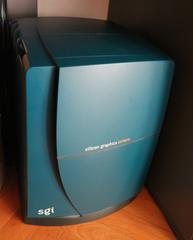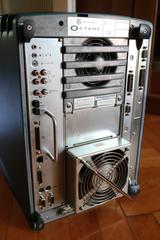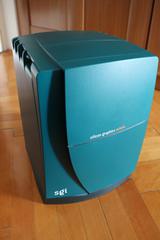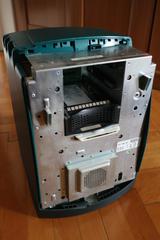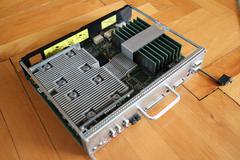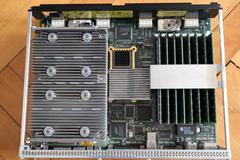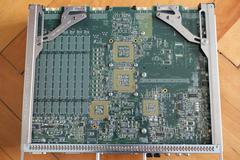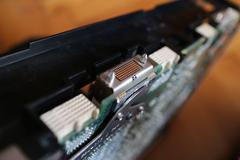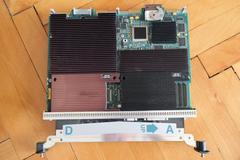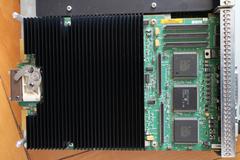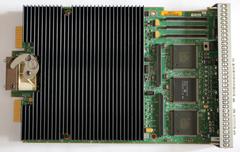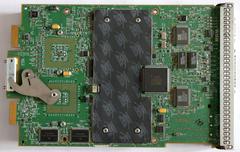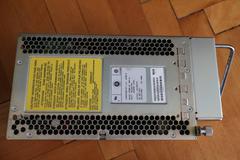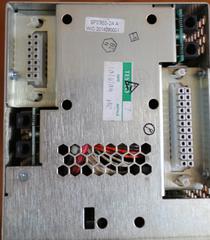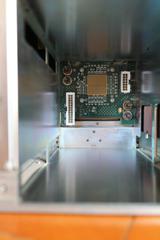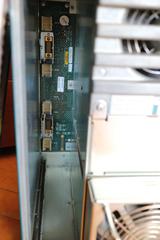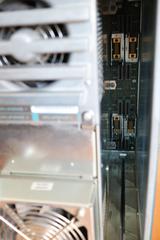SGI Octane
The Silicon Graphics Octane is a graphics workstation from 1997. It was designed as a successor to the Indigo2 workstations and was SGI's first multi-processor desktop workstation. Its contemporary lower-end counterpart was the O2.
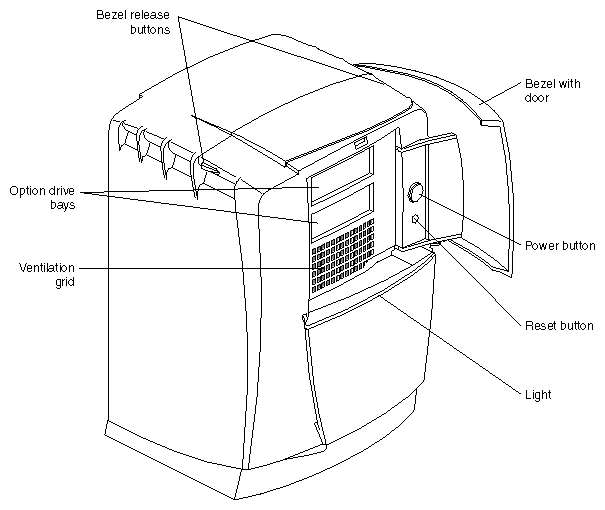
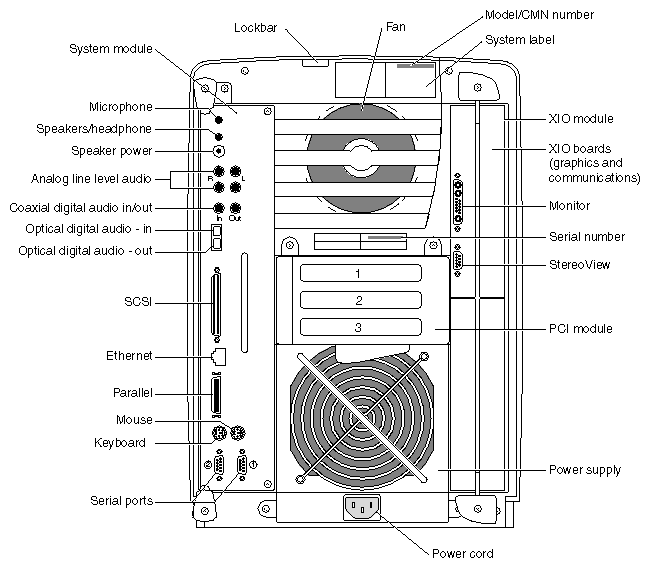
Table of contents
- Architecture
- Hardware configurations
- Processor options
- Memory options
- Graphics options
- IMPACT
- ODYSSEY
- Form factors and multi-head configurations
- Audio/Video I/O options
- My Octane
- Output of hinv -mvv
- Output of scsimon
- Pictures
- Documents
- Acknowledgements
Architecture ↵^
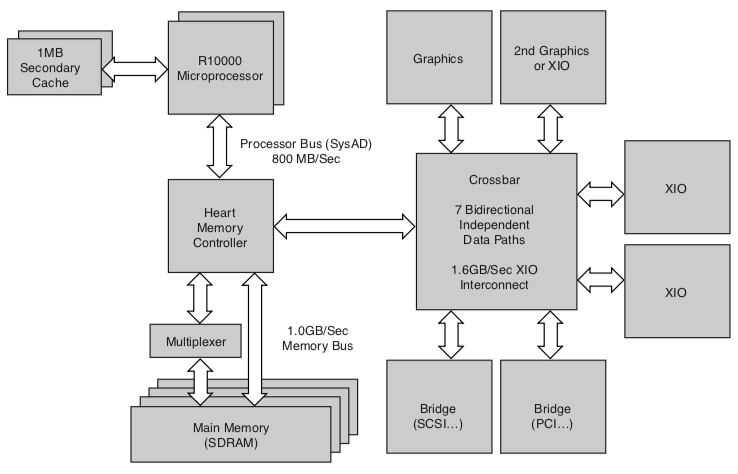
Instead of a traditional shared-bus architecture, the Octane uses a crossbar switch (XBow), which enables various subsystems (CPUs, memory, graphics, I/O) to simultaneously communicate at full speed without slowing down the rest of the machine.
The main chip inside the Octane that connects everything together is the HEART, which serves as a memory controller for 8 slots of proprietary ECC SDRAM DIMMs, and acts as the interface between the memory, the XBow ASIC, and up to 4 processors (however, the maximum configuration was 2 processors, possibly due to the thermal issues of packing four R10k processors in such a small space).
The BRIDGE chip (also located on the mainboard) is responsible for connecting up to 8 standard PCI devices to the Octane's XIO bus. There are four PCI devices connected to this chip — two QLogic QL1040B SCSI controllers, one IOC3 multi-purpose I/O controller (mouse & keyboard, two serial ports, parallel port, 10/100 ethernet, expansion bus for the real-time clock chip, LEDs, etc.), and finally the RAD1 chip, which is a very low-latency audio I/O interface (it supports S/P-DIF, AES/EBU, ADAT, and analog I/O; the latency from input to output is 3ms).
Apart from the graphics cards, the XIO slots can be used for connecting various other expansion cards, from digital video I/O to fibre-channel host adapters.
Hardware configurations ↵^
There are two variants of the Octane — Octane (green chassis) and Octane 2 (blue chassis). The difference between them is in the frontplane (later versions added support for VPro graphics), mainboard (later version supports more RAM), power supply, and graphics.
Most of the upgrades were already performed on existing Octane machines (before they were renamed to Octane 2), so it's common to find the newer Octane 2 boards in an old-style Octane chassis.
Processor options ↵^
The Octane can take either a single or dual processor module. The modules are different, so it's not possible to upgrade a single-processor machine to a dual-processor one simply by adding another module — it needs to be replaced entirely.
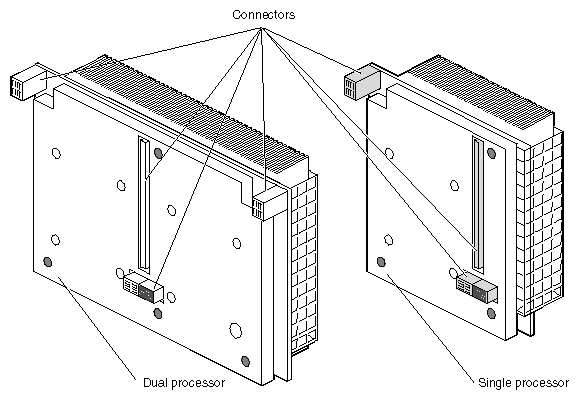
| Processor(s) | Clock speed [MHz] | L1 cache I/D [kB per CPU] | L2 cache I+D [kB per CPU] | Module part number |
|---|---|---|---|---|
| R10000 | 175 | 32/32 | 1024 | 030-1138-00x |
| 2x R10000 | 175 | 32/32 | 1024 | 030-1208-00x |
| R10000 | 195 | 32/32 | 1024 | 030-0888-00x |
| 2x R10000 | 195 | 32/32 | 1024 | 030-0890-00x |
| R10000 | 225 | 32/32 | 1024 | 030-1272-00x |
| R10000 | 250 | 32/32 | 1024 | 030-1284-00x |
| R10000 | 250 | 32/32 | 2048 | 030-1426-00x |
| 2x R10000 | 250 | 32/32 | 1024 | 030-1286-00x |
| R12000 | 270 | 32/32 | 2048 | 030-1432-00x |
| R12000 | 300 | 32/32 | 2048 | 030-1355-00x |
| 2x R12000 | 300 | 32/32 | 2048 | 030-1356-00x |
| R12000 | 360 | 32/32 | 2048 | 030-1590-00x |
| 2x R12000 | 360 | 32/32 | 2048 | 030-1591-00x |
| R12000 | 400 | 32/32 | 2048 | 030-1475-00x |
| R12000A | 400 | 32/32 | 2048 | 030-1605-00x |
| 2x R12000A | 400 | 32/32 | 2048 | 030-1476-00x |
| R14000A | 550 | 32/32 | 2048 | 030-1700-00x |
| R14000A | 600 | 32/32 | 2048 | 030-1776-00x |
| 2x R14000A | 600 | 32/32 | 2048 | 030-1778-00x |
Memory options ↵^
The Octane mainboard has 8 sockets for proprietary ECC SDRAM DIMMs (these are SGI-specific and only work in the Octane, they're not compatible with other SGI computers).
The maximum configuration depends on the revision of the mainboard. The older mainboard (part number 030-0887-00x) has a maximum of 2GB (eight 256MB sticks) and won't work with some newer RAM sticks intended for the later revision board; additionally it's also incompatible with the 270MHz processor module (and probably also with modules above 400MHz). The newer mainboard (part number 030-1467-00x) supports up to 8GB (eight 1024MB sticks) and will work with all RAM sticks and any processor option.
On both motherboard revisions, DIMMs must be installed in equal pairs.
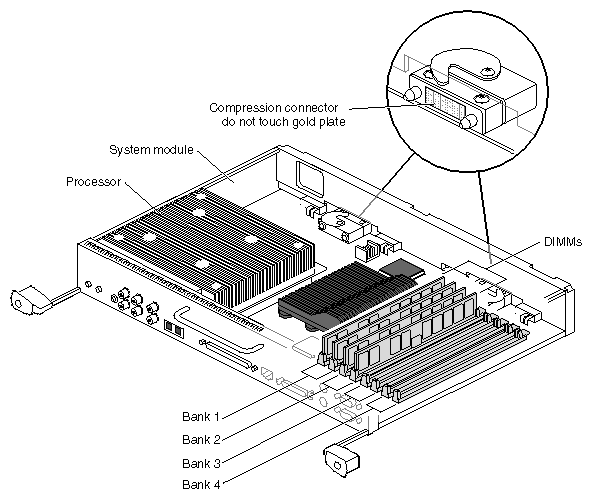
Graphics options ↵^
The Octane has a number of graphics options:
| Graphics option | Architecture | Framebuffer [MB] | Hardware texturing | Width [in XIO slots] | OpenGL version | Module part number |
|---|---|---|---|---|---|---|
| SI | IMPACT | 13.5 | no | 1 | 1.1 | 030-0938-00x |
| SI+T | IMPACT | 13.5 | yes (4MB) | 1 | 1.1 | 030-0938-00x + one 030-1277-00x |
| SSI | IMPACT | 27 | no | 2 | 1.1 | 030-0957-00x |
| MXI | IMPACT | 27 | yes (4MB) | 2 | 1.1 | 030-0957-00x + two 030-1277-00x |
| ESI (a.k.a. SE) | improved IMPACT | 13.5 | no | 1 | 1.1 | 030-1241-00x |
| ESI+T (a.k.a. SE+T) | improved IMPACT | 13.5 | yes (4MB) | 1 | 1.1 | 030-1241-00x + one 030-1263-00x |
| ESSI (a.k.a. SSE) | improved IMPACT | 27 | no | 2 | 1.1 | 030-1240-00x |
| EMXI (a.k.a. MXE) | improved IMPACT | 27 | yes (4MB) | 2 | 1.1 | 030-1240-00x + two 030-1263-00x |
| V6 | ODYSSEY | ~32 | yes (8MB) | 1+ | 1.2 | 030-1403-00x |
| V8 | ODYSSEY | ~128 | yes (104MB) | 1+ | 1.2 | 030-1404-00x |
| V10 | ODYSSEY | ~32 | yes (8MB) | 1+ | 1.2 | 030-1655-00x |
| V12 | ODYSSEY | ~128 | yes (104MB) | 1+ | 1.2 | 030-1611-00x |
IMPACT
IMPACT graphics for the Octane are based on the Indigo2 IMPACT graphics — the first generation contains the exact same chips, but in a different form factor and with a faster bus interface, whereas the second generation contains faster and improved chips. Both generations implement the same level of OpenGL (1.1 + various SGI extensions).
SI, SI+T, ESI, and ESI+T occupy a single XIO slot, whereas SSI, MXI, ESSI, and EMXI occupy two slots. The difference between single- and double-slot IMPACT boards is in the number of geometry engines — double-slot cards have twice as many of them and are therefore faster.
Hardware texturing capability on IMPACT graphics is provided by separate TRAM modules. See the table above for working configurations (note that you can't use older TRAMs on newer IMPACT boards, since they're too slow). On double-slot boards, you need two TRAM modules — this will give you the same 4MB as on a single-slot board, but it will be twice as fast.
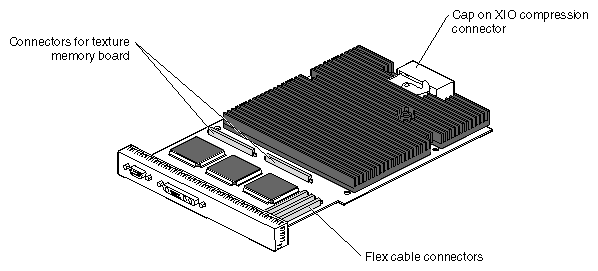 SI or SE graphics board
SI or SE graphics board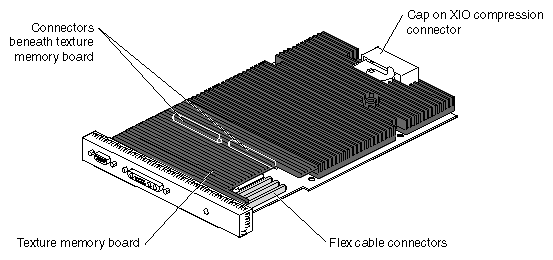 SI+T or SE+T graphics board
SI+T or SE+T graphics board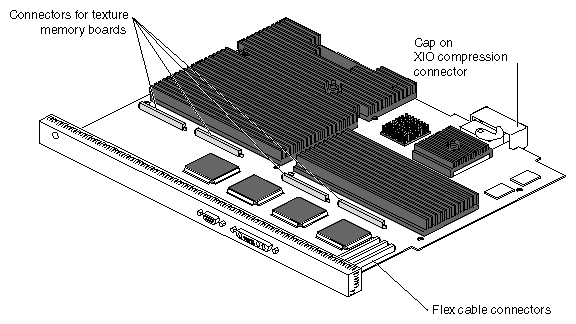 SSI or SSE graphics board
SSI or SSE graphics board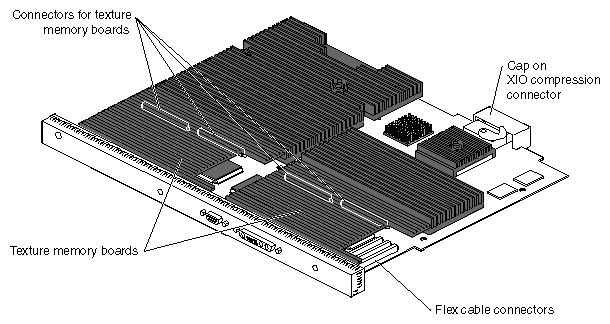 MXI or MXE graphics board
MXI or MXE graphics boardODYSSEY
The ODYSSEY graphics (a.k.a. VPro) are a complete redesign and have a rather nice single-chip implementation of OpenGL. They also come with hardware texturing capability standard even on low-end models, as well as 48-bit RGBA color depth (12-bits per component). The graphics memory is shared between framebuffer and texture RAM.
Form factors and multi-head configurations
The graphics cards connect to the XIO slots on the back of the machine. It's possible to add more than one graphics card, but keep in mind that the SSI/MXI and SSE/MXE take up two slots. The highest configuration is MXE+SE+SE (running two MXE cards is not recommended, because they can't be cooled properly and will eventually die). With ODYSSEY graphics, you need a special carrier for more than one graphics card and you can only have a maximum of two (these cards are thicker than standard XIO cards). However, the V12 boards can be fitted with a Dual-Channel Display option (a.k.a. DCD, part number 030-1512-00x), so with two V12 boards with one DCD each, you can attach four displays.
It's not possible to mix IMPACT and ODYSSEY graphics boards in the same system (you also have to reinstall IRIX's graphics subsystem if you change from IMPACT to ODYSSEY or vice versa).
Audio/Video I/O options ↵^
The built-in audio is based on SGI's proprietary RAD Audio chip, which features low-latency audio streaming (3ms from input to output), and has a variety of I/O: SPDIF/ADAT optical (8 channels at 24-bits for ADAT, 2 channels for SPDIF) and coaxial input and output, two analog line-level inputs and two outputs, microphone input, and headphone output.
If more audio I/O channels are required, additional RAD audio cards in PCI form-factor can be inserted into the Octane's optional PCI card cage. Pictures of the RAD audio PCI board are on my hardware collection's SGI O2 page.
The following XIO cards are available for capturing and outputting video:
- Octane Digital Video option (part number 030-0931-00x + 030-0932-00x) — provides uncompressed digital video I/O with SDI ports (standard definition).
- Octane Personal Video option (part number 030-1156-00x) — provides uncompressed analog video I/O with composite and S-video ports (standard definition), as well as a connector for the O2cam.
- Octane Compression option (part number 030-0933-00x) — provides real-time MJPEG compression for the Digital Video option, but can also function by itself (it has ports for composite and S-video I/O).
- DMediaPro DM2 (part number 030-1653-00x) — high-definition and standard-definition uncompressed digital video I/O, needs a proprietary break-out box for the I/O ports.
The first three video I/O options connect to the graphics board via flexible ribbon cables and are only compatible with IMPACT-based graphics, whereas the DM2 option only works with ODYSSEY graphics. All options also provide a genlock input for synchronization.
My Octane ↵^
My Octane has two 400MHz R12000 processors (with 2MB L2 cache each), 2GB of RAM, and two graphics cards (one MXE and one SE).
Output of hinv -mvv
Location: /hw/node
PM20400MHZ Board: barcode MEG990 part 030-1476-002 rev B
Group ff Capability ffffffff Variety ff Laser 000000599bfd
Location: /hw/node/xtalk/15
IP30 Board: barcode MCM776 part 030-1467-001 rev D
Group ff Capability ffffffff Variety ff Laser 00000059d758
Location: /hw/node/xtalk/15/pci/2
PWR.SPPLY.ER Board: barcode AAE9400078 part 060-0035-002 rev A
Group ff Capability ffffffff Variety ff Laser 00000038733c
FP1 Board: barcode KBX512 part 030-0891-003 rev F
Group ff Capability ffffffff Variety ff Laser 0000002f8795
Location: /hw/node/xtalk/12
MOT20 Board: barcode JKV810 part 030-1240-003 rev G
Group ff Capability ffffffff Variety ff Laser 0000003d7c34
Location: /hw/node/xtalk/11
MOT10 Board: barcode JJN262 part 030-1241-002 rev J
Group ff Capability ffffffff Variety ff Laser 0000003b5f7b
2 400 MHZ IP30 Processors
Heart ASIC: Revision F
CPU: MIPS R12000 Processor Chip Revision: 3.5
FPU: MIPS R12010 Floating Point Chip Revision: 0.0
Main memory size: 2048 Mbytes
Xbow ASIC: Revision 1.4
Instruction cache size: 32 Kbytes
Data cache size: 32 Kbytes
Secondary unified instruction/data cache size: 2 Mbytes
Integral SCSI controller 0: Version QL1040B (rev. 2), single ended
Disk drive: unit 1 on SCSI controller 0 (unit 1)
Integral SCSI controller 1: Version QL1040B (rev. 2), single ended
IOC3/IOC4 serial port: tty1
IOC3/IOC4 serial port: tty2
IOC3 parallel port: plp1
Graphics board: EMXI
Graphics board: ESI
Integral Fast Ethernet: ef0, version 1, pci 2
Iris Audio Processor: version RAD revision 12.0, number 1
PCI Adapter ID (vendor 0x10a9, device 0x0003) PCI slot 2
PCI Adapter ID (vendor 0x1077, device 0x1020) PCI slot 0
PCI Adapter ID (vendor 0x1077, device 0x1020) PCI slot 1
PCI Adapter ID (vendor 0x10a9, device 0x0005) PCI slot 3
Output of scsimon
/dev/scsi/sc0d1l0: [SEAGATE ST336752LC 0004] 55C/131F [65C/149F]
Pictures ↵^
More pictures coming soon!
Documents ↵^
- Octane Workstation Owner's Guide (PDF, 7.4MB)
- Octane Technical Report (PDF, 5.6MB)
- XBow patent (PDF, 931kB)
- BRIDGE patent (PDF, 865kB)
- BRIDGE interrupt translation patent (PDF, 595kB)
Acknowledgements ↵^
All diagrams/drawings on this page were taken from SGI manuals and other documentation.
